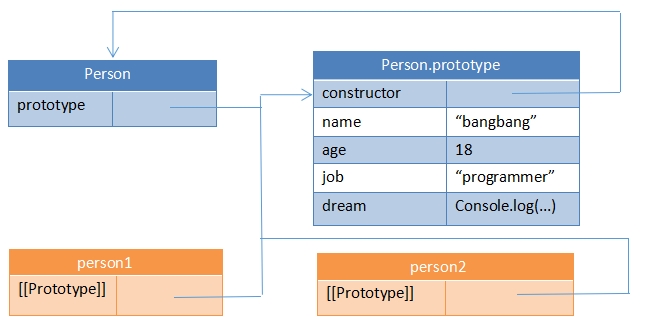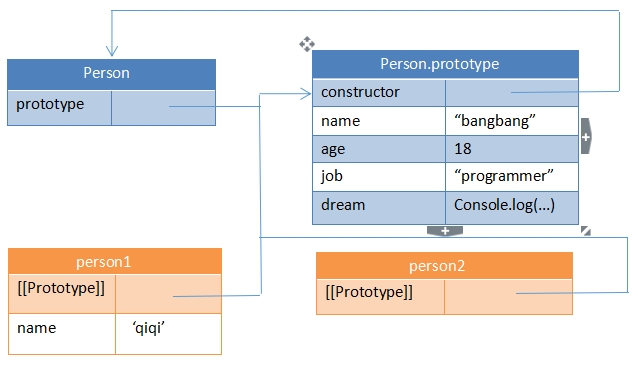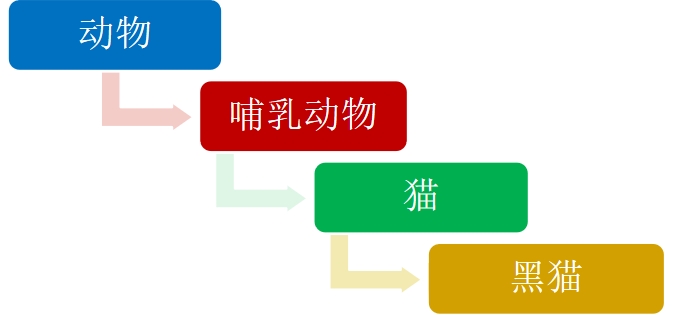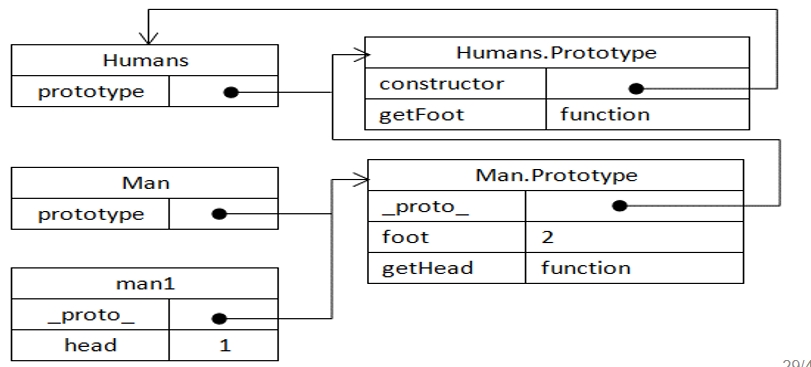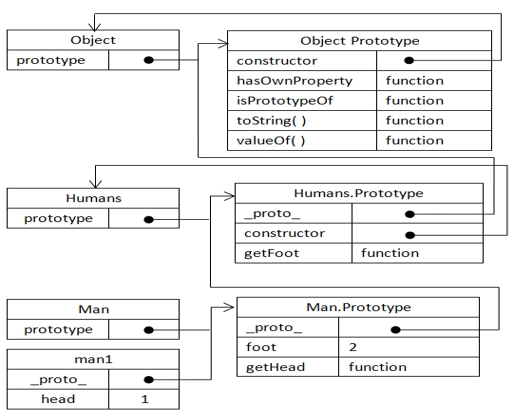对象 对象是包含相关属性和方法的集合体
什么是面向对象
内置对象 常见的内置对象:
String(字符串)对象
length属性
Date(日期)对象
get×××:获取年、月、日、时、分、秒等等
Array(数组)对象
length属性
Boolean(逻辑)对象
true或者false
Math(算数)对象
round( )、max( )、min( )等方法
RegExp对象
RegExp是正则表达式的缩写
自定义对象 操作符new创建对象 1 2 3 4 5 6 7 8 var flower=new Object(); flower.name="长春花"; flower.genera="夹竹桃科 长春花属"; flower.area="非洲、亚热带、热带以及中国大陆的华东、西南、中南等地"; flower.uses="观赏或用药等"; flower.showName=function(){ alert(this.name); } flower.showName();
使用字面量赋值的方式在定义对象 1 2 3 4 5 6 7 8 9 var flower={ name:"长春花", genera:"夹竹桃科 长春花属", area:"非洲、亚热带、热带以及中国大陆的华东、西南、中南等地", uses:"观赏或用药等", showName:function(){ alert(this.name); } } flower.showName();
构造函数 1 2 3 4 5 6 7 8 9 10 11 12 13 14 //构造函数始名称终都应该以一个大写字母开头 function Flower(name,genera,area,uses){ this.name=name; ……. this.showName=function(){ alert(this.name); } } var flower1=new Flower("长春花","夹竹桃科 长春花属", "非洲、亚热带、热带以及中国大陆的华东、西南、中南等地", "观赏或用药等") flower1.showName();
调用构函数的4个步骤
创建一个新对象
将构造函数的作用域赋给新对象(this就指向了这个新对象)
执行构造函数中的代码
返回新对象
constructor属性指向Flower
1 2 3 4 alert(flower1.constructor==Flower); alert(flower2.constructor==Flower); alert(flower3.constructor==Flower);
返回结果未true
使用instanceof操作符检测对象类型
1 2 3 4 5 6 7 alert(flower1 instanceof Object); alert(flower1 instanceof Flower); alert(flower2 instanceof Object); alert(flower2 instanceof Flower); alert(flower3 instanceof Object); alert(flower3 instanceof Flower);
原型对象 什么是原型对象 无论何时,我们创建的每一个函数都有一个prototype属性,这个属性是一个指针,指向一个对象,这个对象包含了通过调用该构造函数所创建的对象共享的属性和方法。其实我们平常的叫法就是指:prototype就是通过该构造函数创建的某个实例的原型对象,但是其实prototype是每个构造函数的属性而已,只能说万物皆对象罢了。
1 2 3 4 5 6 7 8 9 10 11 12 13 14 15 function Flower(){ } Flower.prototype.name="曼陀罗花"; Flower.prototype.genera="茄科 曼陀罗属"; Flower.prototype.area="印度、中国北部"; Flower.prototype.uses="观赏或药用"; Flower.prototype.showName=function() { alert(this.name); } var flower1=new Flower(); flower1.showName(); var flower2=new Flower(); flower2.showName(); alert(flower1.showName==flower2.showName);
1 2 3 4 5 6 7 8 9 10 11 12 13 14 15 16 function Flower(){ } Flower.prototype.name="曼陀罗花"; Flower.prototype.genera="茄科 曼陀罗属"; Flower.prototype.area="印度、中国北部"; Flower.prototype.uses="观赏或药用"; Flower.prototype.showName=function() { alert(this.name); } var flower1=new Flower(); var flower2=new Flower(); flower1.name="长春花"; alert(flower1.name); alert(flower2.name);
原型对象和prototype 我们创建了一个函数,就会根据ECMAscript特定的规则为该函数创建一个prototype属性,这个属性指向函数的原型对象。在默认情况下,所有原型对象都会自动获得一个constructor(构造函数)属性,这个属性是一个指向prototype属性所在函数的指针。就像前面的例子,Person.prototype.constructor指向Person,而通过这个构造函数,我们还可以继续为原型对象添加其他属性和方法。
创建一个自定义的构造函数后,它的原型对象默认只会有constructor属性,其他属性和方法都是从Object继承而来的;
当调用构造函数创建一个新实例后,该实例的内部将包含一个指针,指向构造函数的原型对象。ECMA5中称这个指针叫[[prototype]]。虽然在脚本中没有标准的方式访问[[prototype]],但Firefox、Safari和Chrome在每个对象上都支持一个属性_proto_;而在其他浏览器中,这个属性则是完全不可见的。不过要明确的真正一点就是,这个连接存在于 实例 和 构造函数的原型对象 之间,而不是存在于实例和构造函数之间,用前面使用Person构造函数和Person.prototype创建实例的代码为例,各个对象之间的关系如下图所示:1 2 console.log(Person.prototype.isPrototypeOf(person1));//true console.log(Person.prototype.isPrototypeOf(person2));//true
1 2 console.log(Object.getPrototypeOf(person1) == Person.prototype; // true console.log(Object.getPrototypeOf(person1).name); //'bangbang'
用hasOwnProperty()方法可以检测一个属性是存在于实例中还是原型中。还是上面的例子:
1 2 3 4 5 6 7 console.log(person1.hasOwnProperty('name'); //false person1.name = 'qiqi'; console.log(person1.hasOwnProperty('name'); //true —— 来自实例 console.log(person1.name); //'qiqi' ——来自实例 delete person1.name; console.log(person1.name); //'bangbang' —— 来自原型 console.log(person1.hasOwnProperty('name'); //true ——来自原型
当我们为person1添加name属性的时候,如下图图所示:
创建自定义类型的最常见方式就是组合使用构造函数模式和原型模式。构造函数模式用于定义实例属性,而原型模式用于定义方法和共享的属性。每个实例都会有自己的一份实例属性的副本,但同时又共享着对方发的引用,最大限度的节省了内存。如下例所示:
1 2 3 4 5 6 7 8 9 10 11 12 13 14 15 16 17 18 19 20 21 22 23 function Person(name,age,job){ this.name = name; this.age = age; this.job = job; this.love = ['qiqi','lili']; } Person.prototype = { constructor : Person, dream : function(){ console.log(this.love[0]); } } var person1 = new Person('bangbang',18,'programmer'); var person2 = new Person('xiaoya',18,'teacher'); console.log(person1.love); console.log(person2.love) console.log(person1.love === person2.love); //false //给person1的love属性添加元素 person1.love.push('niuniu'); console.log(person1.love) //["qiqi", "lili", "niuniu"] console.log(person2.love) //["qiqi", "lili"] console.log(person1.love === person2.love); //false console.log(person1.dream === person2.dream);//true
继承 原型链 什么是原型链 每个构造函数都有一个原型对象,原型对象都包含一个指向构造函数的指针,而实例都包含一个指向原型对象的内部指针,那么,假如我们让原型对象等于另一个类型的实例,结果会是怎么样呢?显然,此时的原型对象将包含一个指向另一个原型的指针,相应的,另一个原型中也包含着一个指向另一个构造函数的指针。假如另一个原型又是另一个类型的实例,那么上述关系依然成立,如此层层递进,就构成了实例与原型的链条,这就是原型链的基本概念。
1 2 3 4 5 6 7 8 9 10 11 12 13 14 15 16 17 18 19 20 function Humans(){ this.foot=2; } Humans.prototype.getFoot=function(){ return this.foot; } function Man(){ this.head=1; } Man.prototype=new Humans(); //继承了Humans Man.prototype.getHead=function(){ return this.head; } var man1=new Man(); alert(man1.getFoot()); //2 alert(man1 instanceof Object); //true alert(man1 instanceof Humans); //true alert(man1 instanceof Man); //true
构造函数和原型之间的关系
完整的原型链
对象继承 利用原型让一个引用类型继承另一个引用类型的属性和方法
1 2 3 4 5 6 7 8 9 10 11 12 function Humans(){ this.clothing=["trousers","dress","jacket"]; } function Man(){ } //继承了Humans Man.prototype=new Humans(); var man1=new Man(); man1.clothing.push("coat"); alert(man1.clothing); var man2=new Man(); alert(man2.clothing);
在子类型的构造函数的内部调用超类型构造函数,通过 apply,call 方法实现
1 2 3 4 5 6 7 8 9 10 11 function Humans(name){ this.name=name; } function Man(){ Humans.call(this,"mary"); //继承了Humans,同时还传递了参数 this.age=38; //实例属性 } var man1=new Man(); alert(man1.name); //输出mary alert(man1.age); //输出38
组合继承 有时也叫做伪经典继承
1 2 3 4 5 6 7 8 9 10 11 12 13 14 15 16 17 18 19 20 21 22 23 24 25 26 27 28 29 30 31 32 33 34 35 36 <!DOCTYPE html> <html> <head lang="en"> <meta charset="UTF-8"> <title>组合继承</title> </head> <body> <script> function Humans(name){ this.name=name; this.clothing=["trousers","dress","jacket"]; } Humans.prototype.sayName=function(){ alert(this.name); }; function Man(name,age){ Humans.call(this,name); //继承属性 this.age=age; } Man.prototype=new Humans(); //继承方法 Man.prototype.sayAge=function(){ alert(this.age); }; var man1=new Man("mary",38); man1.clothing.push("coat"); alert(man1.clothing); //输出"trousers,dress,jacket,coat" man1.sayName(); //输出mary man1.sayAge(); //输出38 var man2=new Man("tom",26); alert(man2.clothing); //输出"trousers,dress,jacket" man2.sayName(); //输出tom man2.sayAge(); //输出26 </script> </body> </html>
